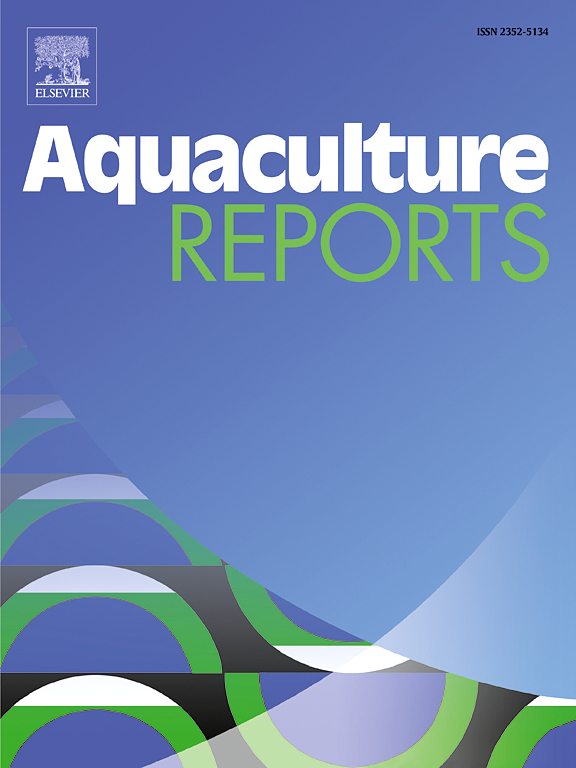共生微生物可改善高小麦淀粉日粮对大口鲈幼鱼生长性能、葡萄糖和脂质代谢的不利影响
IF 3.2
2区 农林科学
Q1 FISHERIES
引用次数: 0
摘要
大口鲈鱼(Micropterus salmoides)对淀粉的利用率很低,目前还不清楚共生微生物是否能减轻高小麦淀粉对大口鲈鱼的不利影响。在此,研究人员从饲喂含 6%、12% 或 18% 淀粉饲料的鲑鱼体内分离出了 12 种能产生淀粉酶的自生微生物。其中,弗赖德柠檬酸杆菌 F1、高度芽孢杆菌 F7、卡氏肠球菌 D12、石蒜单胞菌 D15、卡布里亚柠檬酸杆菌 D16、波特卡柠檬酸杆菌 K25 和奥氏沙雷氏菌 K28 没有溶血活性,对鲑鱼安全。为研究这七种微生物的功能,进行了为期 42 天的喂食实验。将 810 尾鱼(5.9 ± 0.01 克)平均分成 9 组。对照组 C6 和 C18 分别投喂 6 % 和 18 % 的小麦淀粉日粮,F1、F7、D12、D15、D16、K25 和 K28 组分别投喂 18 % 的小麦淀粉日粮并添加 1.0×108 CFU/g C. freundii F1、B. altitudinis F7、E. casseliflavus D12、P. shigelloides D15、B. cabrialesii D16、C. portucalensis K25 和 S. oryzae K28。结果表明,与 6 % 的淀粉相比,18 % 的淀粉水平会抑制生长性能,增加肝糖原和脂肪含量,提高糖酵解相关酶(己糖激酶(HK)、葡萄糖激酶(GK)、磷酸果糖激酶(PFK)、丙酮酸激酶(PK))的活性、降低了与葡萄糖生成有关的酶、丙酮酸羧化酶(PC)和磷酸烯醇丙酮酸羧化酶(PEPCK)的活性,促进了与脂质合成酶有关的肉碱棕榈酰转移酶Ⅰ(CPT1)的活性,降低了与脂蛋白脂肪酶(LPL)有关的脂解酶的活性。C. freundii F1、P. shigelloides D15、C. portucalensis K25 和 S. oryzae K28 的缓解效果相对较差,而 B. altitudinis F7、E. casseliflavus D12 和 B. cabrialesii D16 则显著促进脂肪分解。而 B. altitudinis F7、E. casseliflavus D12 和 B. cabrialesii D16 则显著提高了最终体重(FBW)、增重率(WGR)、特定生长率(SGR)、蛋白质效率比(PER),降低了饲料转化率(FCR),显著降低了肝糖原和脂肪含量,降低了糖酵解相关酶(HK、GK、PK)的活性,提高了葡萄糖生成相关酶(PC、PEPCK)的活性,降低了脂质合成酶相关酶 CPT1 的活性(P < 0.05),证明这三个菌株能有效缓解高淀粉对鲑鱼的负面影响。总之,在七种自产微生物中,B. altitudinis F7、E. casseliflavus D12和B. cabrialesii D16在改善葡萄糖和脂质代谢方面具有更好的潜在优势,从而促进了高淀粉日粮饲喂鲤鱼的生长性能。本文章由计算机程序翻译,如有差异,请以英文原文为准。
Commensal microorganisms ameliorate the adverse effects of high wheat starch diet on the growth performance, glucose and lipid metabolisms in juvenile largemouth bass, Micropterus salmoides
Largemouth bass (Micropterus salmoides) is poor at utilizing starch, and it is not clear whether commensal microorganisms can alleviate the adverse influences of high wheat starch in M. salmoides. Here, twelve autochthonous microorganisms with amylase producing abilities were isolated from the M. salmoides fed with diets containing 6 %, 12 %, or 18 % starch. Among them, Citrobacter freundii F1, Bacillus altitudinis F7, Enterococcus casseliflavus D12, Plesiomonas shigelloides D15, Bacillus cabrialesii D16, Citrobacter portucalensis K25 and Serratia oryzae K28 showed no hemolytic activity and were safety for M. salmoides. A 42-d feeding experiment was performed to study the functions of the seven microorganisms. A total of 810 fish (5.9 ± 0.01 g) were equally distributed into 9 groups. The control groups C6 and C18 were respectively fed with 6 % and 18 % wheat starch diets, the groups F1, F7, D12, D15, D16, K25 and K28 were fed with 18 % wheat starch diets respectively supplemented with 1.0×108 CFU/g C. freundii F1, B. altitudinis F7, E. casseliflavus D12, P. shigelloides D15, B. cabrialesii D16, C. portucalensis K25 and S. oryzae K28. The results indicated that compared with 6 % starch, 18 % level inhibited the growth performance, increased the hepatic glycogen and fat contents, improved the activities of glycolysis-related enzymes (hexokinase (HK), glucokinase (GK), phosphofructokinase (PFK), pyruvate kinase (PK)), decreased the activities of gluconeogenesis-related enzymes, pyruvate carboxylase (PC) and phosphoenolpyruvate carboxykinase (PEPCK), promoted the activity of lipid synthases-related enzyme carnitine palmitoyl transferaseⅠ (CPT1) and reduced the activity of lipolytic enzymes-related lipoprotein lipase (LPL). C. freundii F1, P. shigelloides D15, C. portucalensis K25 and S. oryzae K28 had relatively poor alleviating effects, while B. altitudinis F7, E. casseliflavus D12 and B. cabrialesii D16 significantly promoted the final body weight (FBW), weight gain rate (WGR), specific growth rate (SGR), protein efficiency ratio (PER), decreased feed conversion rate (FCR), significantly reduced the hepatic glycogen and fat contents, decreased the activities of glycolysis-related enzymes (HK, GK, PK), improved the activities of gluconeogenesis-related enzymes (PC, PEPCK), reduced the activity of lipid synthases-related enzyme CPT1 (P < 0.05), which proved that these three strains could effectively alleviate the negative effects of high starch in M. salmoides. In conclusion, among the seven autochthonous microorganisms, B. altitudinis F7, E. casseliflavus D12 and B. cabrialesii D16 presented better potential advantages in improving glucose and lipid metabolisms, thus promoting the growth performance of M. salmoides fed with high wheat starch diet.
求助全文
通过发布文献求助,成功后即可免费获取论文全文。
去求助
来源期刊

Aquaculture Reports
Agricultural and Biological Sciences-Animal Science and Zoology
CiteScore
5.90
自引率
8.10%
发文量
469
审稿时长
77 days
期刊介绍:
Aquaculture Reports will publish original research papers and reviews documenting outstanding science with a regional context and focus, answering the need for high quality information on novel species, systems and regions in emerging areas of aquaculture research and development, such as integrated multi-trophic aquaculture, urban aquaculture, ornamental, unfed aquaculture, offshore aquaculture and others. Papers having industry research as priority and encompassing product development research or current industry practice are encouraged.
 求助内容:
求助内容: 应助结果提醒方式:
应助结果提醒方式:


